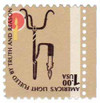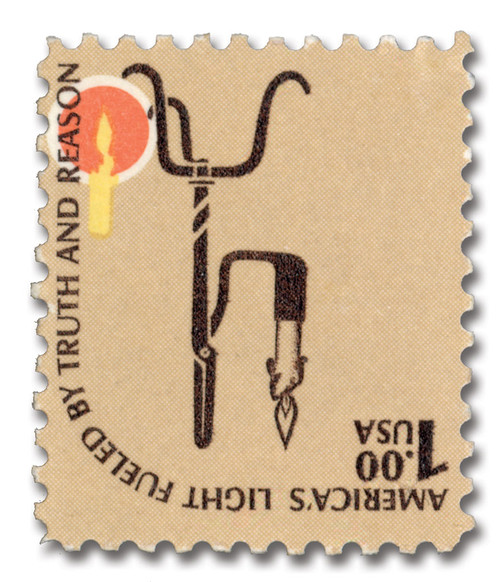
# 1610c - 1979 $1 Americana Series - Rush Lamp CIA Invert
Own The Famous CIA Invert – A Stamp Collector’s Dream
Only 95 Known…
This is your chance to be one of a handful of collectors who can ever own a rare and famous CIA Invert Error stamp. You’ll be owning more than a rarity. You’ll be owning a piece of the most fascinating philatelic detective story of the 20th century. Claim it today and become a part of that story.
It all started in 1986, when news of a recently discovered U.S. invert stamp rocked the philatelic world. It was the first major inverted stamp error in 68 years, but the details were cloaked in secrecy, hidden in a maze of deception that took two years to unravel.
One of the biggest stamp discoveries of the late 20th century
The story began when an auctioneer specializing in U.S. error stamps announced the discovery of 86 inverted 1979 $1 Candleholder stamps. The stamps had been discovered by a “business in northern Virginia” and the finder wished to remain anonymous. The Bureau of Engraving and Printing launched an internal investigation and found that there were no indications of wrong-doing by its employees.
A few months later, Mystic Stamp Company joined with two partners and purchased 50 of the newly discovered inverts. Curious about the origin of the remarkable error, Mystic president Don Sundman filed a Freedom of Information Act request with the Bureau of Engraving and Printing. Months passed. When the report finally arrived, it was accompanied by a cover letter – from the Central Intelligence Agency! Names and words had been blocked out in the 35-page report, but Don was able gather enough information to trace the stamps directly back to the CIA.
CIA Employees Profit from “Candleholder Invert Caper”!
An on-duty CIA employee had purchased the partial sheet of 95 inverted stamps at a small post office near McLean, Virginia. When he and his office colleagues realized what they had, they pooled their money and substituted non-error $1 candleholder stamps for the inverts. Each of the nine co-workers kept a stamp. The remaining 85 stamps were quietly sold to the auctioneer and he was given the one damaged copy.
When Don Sundman broke the story in Linn’s Stamp News, it made headlines across the nation and was featured on every major television network. It made the front page of the New York Times, the Washington Post and the Wall Street Journal. The CIA launched an ethics investigation and demanded the co-workers surrender their inverts or face 10 years in prison and a $10,000 fine for conversion of government property for personal gain. Five employees returned their stamps, one claimed his had been lost and was fired, and three people resigned.
The CIA donated the recovered inverts to the National Postal Museum, where they joined a copy donated earlier by Don Sundman. Investigations conducted by the Bureau of Printing and Engraving and the Justice Department cleared the co-workers of any wrongdoing.
Unlikely Series of Events Creates Inverted Design
An odd and unlikely series of events caused this invert. The candleholder stamp was printed on two separate printing presses in different buildings. Sheets came off the first press with the image of the printed flame face down, gum side up. The paper mill that manufactured the paper normally delivered rectangular sheets of paper with a triangle cut off the bottom left corner. This allowed one inverted sheet to stick out and easily be caught by quality control. After six years of printing the candlestick stamp design, the corner cuts had been discontinued. A batch of paper was delivered to the BEP without this feature, allowing for the inadvertent reversal of the sheet. History was made when the error was printed and distributed to the public.
The “White Line” CIA Invert Error – The Centerpiece of Your Collection
When the original Candleholder Invert stamps were printed, they were laid out in four panes of 100, with only one pane ever discovered. The white line on the stamp offered here is the margin that would have been between the left and right panes if the sheet had not been reversed. This makes the stamp even scarcer than the others on the original sheet without the white line. And it only adds to the fascinating history of this sought-after invert!
Be part of philatelic history and one of the greatest stamp stories of all time by becoming the owner of a CIA Invert error stamp. Make it yours today with interest-free time payments. It will be the centerpiece of your U.S. stamp collection!
Own The Famous CIA Invert – A Stamp Collector’s Dream
Only 95 Known…
This is your chance to be one of a handful of collectors who can ever own a rare and famous CIA Invert Error stamp. You’ll be owning more than a rarity. You’ll be owning a piece of the most fascinating philatelic detective story of the 20th century. Claim it today and become a part of that story.
It all started in 1986, when news of a recently discovered U.S. invert stamp rocked the philatelic world. It was the first major inverted stamp error in 68 years, but the details were cloaked in secrecy, hidden in a maze of deception that took two years to unravel.
One of the biggest stamp discoveries of the late 20th century
The story began when an auctioneer specializing in U.S. error stamps announced the discovery of 86 inverted 1979 $1 Candleholder stamps. The stamps had been discovered by a “business in northern Virginia” and the finder wished to remain anonymous. The Bureau of Engraving and Printing launched an internal investigation and found that there were no indications of wrong-doing by its employees.
A few months later, Mystic Stamp Company joined with two partners and purchased 50 of the newly discovered inverts. Curious about the origin of the remarkable error, Mystic president Don Sundman filed a Freedom of Information Act request with the Bureau of Engraving and Printing. Months passed. When the report finally arrived, it was accompanied by a cover letter – from the Central Intelligence Agency! Names and words had been blocked out in the 35-page report, but Don was able gather enough information to trace the stamps directly back to the CIA.
CIA Employees Profit from “Candleholder Invert Caper”!
An on-duty CIA employee had purchased the partial sheet of 95 inverted stamps at a small post office near McLean, Virginia. When he and his office colleagues realized what they had, they pooled their money and substituted non-error $1 candleholder stamps for the inverts. Each of the nine co-workers kept a stamp. The remaining 85 stamps were quietly sold to the auctioneer and he was given the one damaged copy.
When Don Sundman broke the story in Linn’s Stamp News, it made headlines across the nation and was featured on every major television network. It made the front page of the New York Times, the Washington Post and the Wall Street Journal. The CIA launched an ethics investigation and demanded the co-workers surrender their inverts or face 10 years in prison and a $10,000 fine for conversion of government property for personal gain. Five employees returned their stamps, one claimed his had been lost and was fired, and three people resigned.
The CIA donated the recovered inverts to the National Postal Museum, where they joined a copy donated earlier by Don Sundman. Investigations conducted by the Bureau of Printing and Engraving and the Justice Department cleared the co-workers of any wrongdoing.
Unlikely Series of Events Creates Inverted Design
An odd and unlikely series of events caused this invert. The candleholder stamp was printed on two separate printing presses in different buildings. Sheets came off the first press with the image of the printed flame face down, gum side up. The paper mill that manufactured the paper normally delivered rectangular sheets of paper with a triangle cut off the bottom left corner. This allowed one inverted sheet to stick out and easily be caught by quality control. After six years of printing the candlestick stamp design, the corner cuts had been discontinued. A batch of paper was delivered to the BEP without this feature, allowing for the inadvertent reversal of the sheet. History was made when the error was printed and distributed to the public.
The “White Line” CIA Invert Error – The Centerpiece of Your Collection
When the original Candleholder Invert stamps were printed, they were laid out in four panes of 100, with only one pane ever discovered. The white line on the stamp offered here is the margin that would have been between the left and right panes if the sheet had not been reversed. This makes the stamp even scarcer than the others on the original sheet without the white line. And it only adds to the fascinating history of this sought-after invert!
Be part of philatelic history and one of the greatest stamp stories of all time by becoming the owner of a CIA Invert error stamp. Make it yours today with interest-free time payments. It will be the centerpiece of your U.S. stamp collection!







